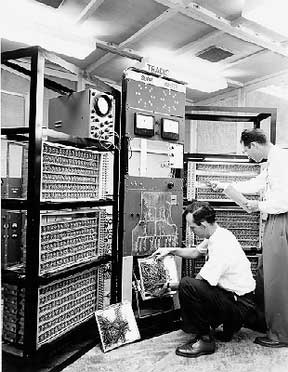The history of computer development is often in reference to the different generations of computing devices. Each of the generation of computers is characterized by a major technological development
(switching technology)that fundamentally changed the way computers operate. Most major
developments resulted in increasingly smaller, cheaper and more powerful
and efficient computing devices. The evolution of computers are categorized in five generations:
 The period of first generation was 1946-1959. The computers of first
generation used vacuum tubes as the basic components for memory and
circuitry for CPU (Central Processing Unit). These tubes, like electric
bulbs, produced a lot of heat and were prone to frequent fusing of the
installations, therefore, were very expensive and could be afforded only
by very large organisations. In this generation mainly batch processing
operating system were used. Punched cards, paper tape, and magnetic
tape were used as input and output devices. The computers in this
generation used machine code as programming language.
The period of first generation was 1946-1959. The computers of first
generation used vacuum tubes as the basic components for memory and
circuitry for CPU (Central Processing Unit). These tubes, like electric
bulbs, produced a lot of heat and were prone to frequent fusing of the
installations, therefore, were very expensive and could be afforded only
by very large organisations. In this generation mainly batch processing
operating system were used. Punched cards, paper tape, and magnetic
tape were used as input and output devices. The computers in this
generation used machine code as programming language.
The main features of first generation are:
- 1st Generation (Vacuum Tube)
- 2nd Generation (Transistor)
- 3rd Generation (Integrated circuit)
- 4th Generation (VLSI)
- 5th Generation (ULSI, Parallel Computing, Artificial Intelligence)
Computer - First Generation
 The period of first generation was 1946-1959. The computers of first
generation used vacuum tubes as the basic components for memory and
circuitry for CPU (Central Processing Unit). These tubes, like electric
bulbs, produced a lot of heat and were prone to frequent fusing of the
installations, therefore, were very expensive and could be afforded only
by very large organisations. In this generation mainly batch processing
operating system were used. Punched cards, paper tape, and magnetic
tape were used as input and output devices. The computers in this
generation used machine code as programming language.
The period of first generation was 1946-1959. The computers of first
generation used vacuum tubes as the basic components for memory and
circuitry for CPU (Central Processing Unit). These tubes, like electric
bulbs, produced a lot of heat and were prone to frequent fusing of the
installations, therefore, were very expensive and could be afforded only
by very large organisations. In this generation mainly batch processing
operating system were used. Punched cards, paper tape, and magnetic
tape were used as input and output devices. The computers in this
generation used machine code as programming language.The main features of first generation are:
- Vacuum tube technology
- Unreliable
- Supported machine language only
- Very costly
- Generated lot of heat
- Slow input and output devices
- Huge size
- Need of A.C.
- Non-portable
- Consumed lot of electricity
- ENIAC
- EDVAC
- UNIVAC
- IBM-701
- IBM-650
No comments:
Post a Comment